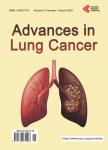Clinicopathological Profile of Lung Cancers at an Institute from South India—A Record Based Retrospective Cohort Study
Clinicopathological Profile of Lung Cancers at an Institute from South India—A Record Based Retrospective Cohort Study作者机构:HealthCare Global Enterprise Ltd. Bangalore India Biocon Bangalore India
出 版 物:《Advances in Lung Cancer》 (肺癌(英文))
年 卷 期:2020年第9卷第3期
页 面:41-54页
学科分类:1002[医学-临床医学] 100214[医学-肿瘤学] 10[医学]
主 题:Lung Neoplasms Adenocarcinoma Squamous Cell Carcinoma Small Cell Lung Carcinoma
摘 要:Introduction: Apart from smoking as the known risk factor for lung cancer, recent developments implicate occupational exposure to carcinogens, indoor air pollution and dietary factors as other causative agents. In our study, we have analyzed the clinical and pathological profile of lung cancer patients treated at our center over a period of 8 years. Aim: To find the demographic and clinicopathological profile of lung cancer patients admitted to the oncology unit. Methods: This retrospective record based analysis includes a cohort of 1248 patients diagnosed with lung cancer, at a tertiary cancer care center in Bangalore, South India. This study includes data of patients admitted during the period 2010 to 2018, retrieved from the Hospital’s emergency medical records (EMR). Their demographic profile, clinical correlates, radiological profile and diagnostic details were studied. Benign tumours, malignant pleural disease and sarcomatoid tumors were excluded from this study. Results: Adenocarcinoma (AC) was detected among 70.4% of patients, Squamous cell carcinoma (SCC) among 15.3% and Small cell lung cancer (SCLC) among 14.3% of lung cancer admissions. Male to female ratio was 2.95:1. It was found that the median age of lung cancer patients was 61 years. 60% of lung cancer patients were from the 51 - 70 year age-group. Across the three types of cancers among the patients in Stage 3B to 4 strata, 35% received palliative chemotherapy and 20% received palliative chemotherapy + radiation. Conclusion: In our study, AC is the most common histological subtype (70%) of lung cancer. The outcome of lung cancer patients can be considerably impacted by addressing risk factors through preventive measures implemented in the community.



